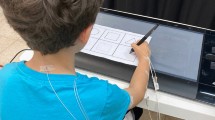Abstract
Production of drawing movements was studied in 29 right-handed children aged 9 to 11 years. The movements were sequences of horizontal and vertical linear strokes conjoined at a right angle (open polygonal chains) referred to below as trajectories. Trajectories comprising four to six segments were presented to a subject visually in a static or dynamic mode (i.e., as a linear drawing or as a moving cursor leaving no trace). The subjects were asked to draw (copy) the trajectory as fast as possible without lifting the pen in response to a delayed go-signal (short click). The parameters analyzed were the production latency time, the average duration of movement along a trajectory segment, and the overall number of errors made by a subject while producing the trajectory. Comparison of the data obtained in children with similar data for adults (16 subjects) revealed the following patterns. First, between the ages of 9 and 11 years, the error rate rapidly decreased for both the static and the dynamic modes of presentation, although 11-year-old children still made more errors than adults. Second, the average movement duration shortened with age, while the latency time tended to increase. Third, in 9- to 11-year-old children, in contrast to adults, the latency times for the static and dynamic modes of trajectory presentation did not differ from each other. The differences in trajectory production between adults and children are attributed to the predominant involvement of on-line programming in children and preprogramming in adults.
Similar content being viewed by others
References
Bullock, D., Adaptive neural models of queuing and timing in fluent action, Trends Cogn. Sci., 2004, vol. 8, no. 9, p. 426.
Bradley, C. and Pearson, J., The sensory components of high-capacity iconic memory and visual working memory, Front. Psychol., 2012, vol. 3, p. 355.
Rensink, R.A., Limits to the use of iconic memory, Perception, 2008, vol. 37, p. 45.
Sligte, I.G., Scholte, H.S., and Lamme, V.A., Are there multiple visual short-term memory stores?, PLoS One, 2008, vol. 3, no. 2, e1699.
Bays, P.M. and Husain, M., Dynamic shifts of limited working memory resources in human vision, Science, 2008, vol. 321, no. 5890, p. 851.
Matsukura, M. and Hollingworth, A., Does visual short-term memory have a high-capacity stage?, Psychon. Bull. Rev., 2011, vol. 18, no. 6, p. 1098.
Korneev, A.A. and Kurgansky, A.V., Internal representation of movement sequences built upon either static line drawings or trajectories of a moving object, Zh. Vyssh. Nervn. Deyat. im. I.P. Pavlova, 2013, vol. 63, no. 4, p. 437.
Davidson, M.C., Amso, D., Anderson, L.C., and Diamond, A., Development of cognitive control and executive functions from 4 to 13 years: evidence from manipulations of memory, inhibition, and task switching, Neuropsychologia, 2006, vol. 44, no. 11, p. 2037.
Luciana, M., Conklin, H.M., Hooper, C.J., and Yarger, R.S., The development of nonverbal working memory and executive control processes in adolescents, Child. Dev., 2005, vol. 76, no. 3, p. 697.
Kurgansky, A.V., Development and regulation of finely coordinated cyclic hand movements in children of preschool and early school age, Novye Issled., 2013, vol. 40, no. 1. p. 9.
Dunabeitia, J.A., Dimitropoulou, M., Estevez, A., and Carreiras, M., The influence of reading expertise in mirror-letter perception: evidence from beginning and expert readers, Mind Brain Educ., 2013, vol. 7, no. 2. doi: 10.1111/mbe.12017
Schott, G.D., Mirror writing: neurological reflections on an unusual phenomenon, J. Neurol. Neurosurg. Psychiatry, 2007, vol. 78, no. 1, p. 5.
Kurgansky, A.V., The relationship between the maximal rate of production of simple periodic hand movement sequences and their structural complexity. The age factor, Novye Issled., 2011, vol. 28, no. 3, p. 18.
Kurgansky, A.V. and Grigal, P.P., Directed corticocortical functional connectivity at the early stages of serial learning in adults and seven- to eight-year old children, Hum. Physiol., 2010, vol. 36, no. 4, p. 408.
Yan, J.H., Thomas, J.R., Stelmach, G.E., and Thomas, K.T., Developmental features of rapid aiming arm movements across the lifespan, J. Mot. Behav., 2000, vol. 32, no. 2, p. 121.
Kurgansky, A.V. and Kurgansky, M.E., Age-related changes in the spatiotemporal structure of simple cyclical graphic movements performed at the maximal rate: I. The increase in the movement rate is accounted for by reduction of the number of submovements in a movement cycle, Hum. Physiol., 2011, vol. 37, no. 1, p. 22.
Chartrel, E. and Vinter, A., The impact of spatio-temporal constraints on cursive letter handwriting in children, Learn. Instr., 2008, vol. 18, p. 537.
Kiselev, S., Espy, K.A., and Sheffield, T., Age-related differences in reaction time task performance in young children, J. Exp. Child Psychol., 2009, vol. 102, no. 2, p. 150.
Badan, M., Hauert, C.A., and Mounoud, P., Sequential pointing in children and adults, J. Exp. Child Psychol., 2000, vol. 75, no. 1, p. 43.
Ketelaars, A.C., Garry, M.I., and Franks, I.M., Online programming of simple movement sequences, Hum. Mov. Sci., 1997, vol. 16, p. 461.
Smiley-Oyen, A.L. and Worringham, C.J., Peripheral constraint versus on-line programming in rapid aimed sequential movements, Acta Psychol. (Amst.), 2001, vol. 108, no. 3, p. 219.
Rhodes, B.J., Bullock, D., Verwey, W.B., Averbeck, B.B., and Page, M.P., Learning and production of movement sequences: behavioral, neurophysiological, and modeling perspectives, Hum. Mov. Sci., 2004, vol. 23, no. 5, p. 699.
Author information
Authors and Affiliations
Corresponding author
Additional information
Original Russian Text © A.A. Antonova, K.A. Absatova, A.A. Korneev, A.V. Kurgansky, 2015, published in Fiziologiya Cheloveka, 2015, Vol. 41, No. 2, pp. 38–45.
Rights and permissions
About this article
Cite this article
Antonova, A.A., Absatova, K.A., Korneev, A.A. et al. Delayed motor production of open polygonal chains presented visually in static and dynamic modes: Comparison between 9- to 11-year-old children and adults. Hum Physiol 41, 143–149 (2015). https://doi.org/10.1134/S0362119715020036
Received:
Published:
Issue Date:
DOI: https://doi.org/10.1134/S0362119715020036



